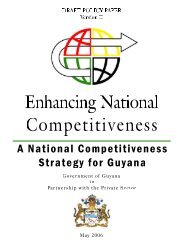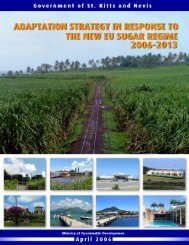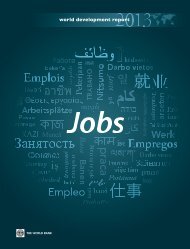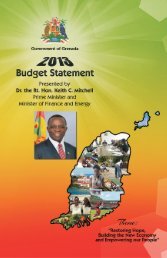Business Removing
Doing Business in 2005 -- Removing Obstacles to Growth
Doing Business in 2005 -- Removing Obstacles to Growth
- No tags were found...
Create successful ePaper yourself
Turn your PDF publications into a flip-book with our unique Google optimized e-Paper software.
MEASURING WITH IMPACT 13<br />
to start a business to double that in most other cities.<br />
Some of the same patterns that hold across countries are<br />
visible at the subnational level—for example in Brazil<br />
the cities with higher official fees for registering property<br />
are also the cities with the longest time.<br />
Such within-country work is necessary to identify<br />
constraints and design reforms. Here, the methodology<br />
developed by Doing <strong>Business</strong> again offers advantages<br />
over the alternative methods. It is significantly cheaper<br />
than running enterprise surveys. And it is much more<br />
accurate than asking a New York-based expert about<br />
business constraints in Porto Velho (the 60th largest city<br />
in Brazil).<br />
Still, there is room for improvement. Changes have<br />
been made to every set of indicators. For example, last<br />
year the statutory requirement for minimum capital was<br />
taken as part of the initial cost of starting a business. But<br />
in a number of countries, only a part of the mandated<br />
minimum capital needs to be paid up-front, with the<br />
rest paid over time. For example, only 25% is paid upfront<br />
in Germany, 30% in Italy and 50% in Armenia. The<br />
revised indicator reflects the up-front cost only.<br />
Indicators of credit markets were also improved.<br />
Doing <strong>Business</strong> in 2004 reported a measure of the legal<br />
rights of creditors in insolvency. This year, the measure<br />
is expanded to cover collateral laws as well—which define<br />
legal rights that help both borrowers and lenders.<br />
And indicators on credit information were simplified<br />
to an index of 6 variables, covering information sharing<br />
from both public and privately owned registries.<br />
As another example, last year’s methodology for enforcing<br />
a contract did not allow for a creditor to seek recovery<br />
outside the courts. This assumption was made in<br />
the belief that such actions may always be reversed by a<br />
FIGURE 2.5<br />
High costs to fire in some countries<br />
Cost to fire (weeks)<br />
0 50 100 150<br />
New Zealand<br />
Algeria<br />
South Africa<br />
Honduras<br />
Congo, Dem. Rep.<br />
India<br />
Romania<br />
Angola<br />
Greece<br />
Guatemala<br />
Notice<br />
Source: Doing <strong>Business</strong> database.<br />
Severance<br />
Penalty for dismissal<br />
later court judgment and are not preferred by creditors.<br />
But several countries—for example, Belgium, France<br />
and Greece—have administrative debt collection procedures<br />
that are binding for both debtors and creditors.<br />
This year, administrative procedures are used for countries<br />
where the respondents indicate they are the most<br />
common method.<br />
A different problem arises when the respondents describe<br />
how entrepreneurs would register a business, go<br />
to court or enter bankruptcy—but in reality have dealt<br />
little with such transactions. To gauge their experience,<br />
this year’s surveys collected information on how many<br />
such transactions the respondent completed. The new<br />
evidence shows that the average incorporation lawyer<br />
dealt with more than 100 cases of business entry in 2003.<br />
And because Doing <strong>Business</strong> has about 500 respondents<br />
on starting a business, the data reported here reflect experience<br />
with more than 50,000 transactions for the<br />
whole sample—for only one of the topics in Doing <strong>Business</strong>.<br />
Beyond the arithmetic, a professional dealing with<br />
these issues every day can differentiate between usual<br />
costs and delays and those under extraordinary circumstances.<br />
To inspire reform, indicators need to be simple.<br />
Changes to the methodology have been made where<br />
users of the indicators said they had trouble understanding<br />
them. For example, last year’s indices on the rigidity<br />
of employment regulation were based on a reading of<br />
the laws and varied from 0 (less rigid regulation) to 100<br />
(more rigid regulation). Many business people asked<br />
whether the indices could be presented in terms of costs.<br />
So this year, a new indicator on the cost of firing a redundant<br />
worker has been constructed (figure 2.5), measured<br />
in terms of weeks of wages.<br />
For another example, last year’s indicators on the<br />
difficulty of closing a business looked at the cost, time,<br />
priority of claims and extent of court involvement. Policymakers<br />
have said that they are most concerned about<br />
how much value is being lost in inefficient bankruptcy<br />
procedures. The result is a new indicator, which calculates<br />
how many cents on the dollar can be recovered in<br />
bankruptcy (figure 2.6).<br />
Once the simple indicator triggers interest in reform,<br />
by comparing it with those for other countries and<br />
by showing the economic and social benefits of improvement,<br />
more detailed information collected by the<br />
Doing <strong>Business</strong> team can be used to assist the reformers.<br />
One example is the indicators on registering property.<br />
Once the government of Malawi acknowledges the need<br />
to make registration more efficient, the depth of the

















